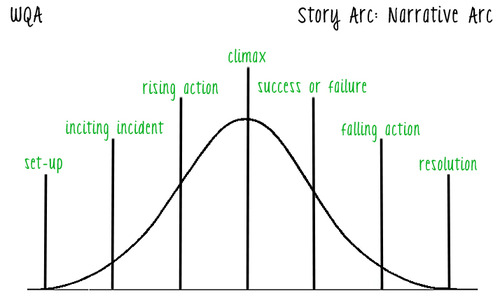Company Blogging Done Best (or, Make Sure It's Not a Snoozefest)
Company blogs shouldn't be putting you to sleep, so use my tips for making yours something worth reading. Write great content, present it in a fun way, and see your following grow.

At Wiredcraft, we’re always trying to be better. With all of our growth and the changes we’re experiencing, we’ve realized that investing in a high-quality company blog is essential to the next phase of our existence. We all have stories to tell
The company blog is often the primary vehicle for promoting our brand and building a following. Given this level of importance, we should be exerting considerable effort to make it better. The team is our product, an excellent one at that, but no one will know that unless: a) they’ve worked with us; or b) we tell them. We need to have a kickass blog so we can tell the world what’s going on at Wiredcraft and why they should care (and hopefully give us their money).
What should my blog post do?
Your blog post should serve to explain a specific facet of what’s going at your company - what tech are we using, who’s joining the team, what challenges do we face, and so on. We want the blog to market our team and its value, so we need to build an engaged base of readers and hold their interest. To that end, we need to produce compelling and interesting content. Your post should capture a reader’s attention and point them to something worthwhile, such as a previous or current project or to a specific action (follow us on Twitter, tell us about your project, et cetera).
How should I start my blog post?

At the top of every blog post, think of the context, think about why you’re writing this post. (No, not because we asked!) If you’re writing about a new process the team is using, explain why the old one didn’t work or how much better the new one is. New piece of technology? Tell the audience why it’s awesome/better or what you want to do with it. Think about your post’s subject and why it matters and why an audience member wants to read about it.
A helpful viewpoint for our company blog: walk the reader through a day in your life. Don’t say “I’m going to…” Show, don’t tell.
How should I structure my blog post?
Your blog post should have a narrative flow to it. The most common: the story arc.

Extremely common and tried-and-true, this method is a good starting point for developing your content. Tell a story and walk the audience through your thinking. There is typically some sort of obstacle (building a tool, testing code, recruiting good talent) that drives the story and should drive your post.
First, set up the scenario. Answer some of the five Ws; share what you’re doing, why, and how. The who, when, and where can be helpful, but aren’t always necessary. This introduction should give context to what you’re doing and why you’re writing about it. It should also be short and crisp - you’ll lose readers quickly if you lead with a heavy introduction.
Next, introduce the obstacle, the action behind the blog post. Tell us about the project you’re working on (if there’s no NDA) or anonymize the client and avoid specifics on the work, depending on the contract’s specifics.
Finally, concluding the posts is crucial to making the blog actually useful. Instead of ending on a weak note like “that’s how you do this activity with this thing.” Instead, entice the audience to do one more thing by employing a “call-to-action,” or a CTA. Direct people to read another blog post, follow us on social media, check out something cool, or (even better) contact us to learn more about what we’re doing and how we can help them.
How can the blog be more engaging?
Readers tend not to enjoy large blocks of text, nor should they. It’s important to break walls of text into digestible chunks, paragraphs that are only a handful of lines long. Not only should the post’s text be broken into paragraphs, the overall text should be interrupted by the occasional graphic, pull quote, or other sort of interesting piece of content. A well-placed diagram explaining the server process, an embed from YouTube, or a fun gif that’s related to the post’s content can really keep readers’ attention.
Titles should be kept crisp, compelling, and concise. Blog titles need to be optimized for the sake of SEO, but also to grab the attention of potential readers. Lightening the Load with Falcor JS is an excellent lang: en title: it explains a lot in very few words. I know what it’s about, what it can teach me, and it grabs my interest. Avoid using generic titles, like “How to Write a Blog Post.” It’s boring, inane, and incredibly non-specific. Being innocuous doesn’t build success.
Avoid using too much technical language in your posts or you’ll lose your audience. Obviously, a fair amount will be necessary to explain concepts in posts about technical topics, but make an effort to use analogies and plainer language to explain the concepts to your non-technical audience members.
Don’t be afraid to incorporate links. These can break up the monotony of plain text and guide readers to what they need to be seeing. Linking to relevant articles, fun content, and sh*t that matters builds trust with the readers because they’ll keep coming back for more. Where reasonable, be sure to place links to the company blog and examples of our past and current work, but don’t avoid connecting to outside sites and resources.
How do I make my blog more personable?
People like when their machines feel human. We want to train our chatbots and we put faces on our robots (and we make them dance). Reading articles is much more fun when they have voice and personality. Nobody truly enjoys reading textbooks. (Shut up, nerds!) A blog isn’t a textbook and shouldn’t feel like one, either.
When writing your blog posts, share more than just the facts. Do you like a new process or piece of technology? Tell us what’s better and what’s best and why. If you’re excited or frustrated with something, that’s useful information to share. Add flavor to your posts by using jokes, colorful language, and personal storytelling. Write something you’d want to read and think that others would enjoy, too.
Get blogging, folks
Thanks for tuning in, beloved readers. This has been a fun article to produce and I hope it’s been fun to read. If you have any tips of your own or want to throw your blog my way, send me one of those new-fangled tweets, tweet us all at Wiredcraft, or shoot us an email. Three cheers for blogging!
